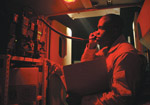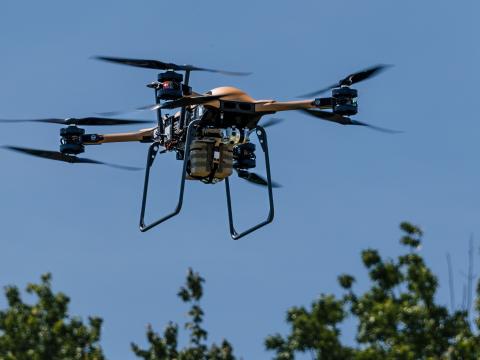Security, Regionalization Dominate Marine Information Technology Needs
 |
| A U.S. Marine sergeant radios other Marines during an operation in Iraq’s Al Anbar province. The Marine Corps is extending network connectivity down to company level and below, and this is posing several techno-logical challenges. |
The U.S. Marine Corps is looking for more than a few good men and women as it increases the size of its command, control, communications and computers force. The Corps is adding a large number of civilians to the mix of uniformed Marines along with contractors to address burgeoning needs in warfighter connectivity and networking.
Where until recently the Marine Corps was satisfied with providing network connectivity at the regiment level and above, it now must provide that connectivity at the company level. In some cases, the network must extend even lower. This requires accompanying extensions in security and information technology support, particularly training.
Extending the network also stresses bandwidth availability. Warfighters in
Maj. Gen. (s) George J. Allen, USMC, is the director of Marine Corps Command, Control, Communications and Computers (C4),
Gen. Allen relates that this doctrine goes far beyond teaching Marines how to use the new gear, however. The effort includes uniformed, civilian Marine and contractor personnel. And, the goal is not just competence; it is to empower each individual with the ability to embrace new technologies and to introduce innovative concepts quickly.
The general continues that his office is working with the Marine Corps Training and Education Command to expand its online information technology education presence. Communications training centers recently have been established in
The Marine Corps already is working with U.S. Army Signal School branches for virtual and online training. In addition to providing instruction, virtual training for Marines also focuses on real combat skill sets. Both disciplines will be important parts of Marine online training.
Another key training area is information security. Gen. Allen notes that, traditionally, information security and information assurance have been add-on capabilities. But now, security is ingrained in all activities throughout the entire acquisition process. The result has been more secure operations, he warrants.
But one of the biggest changes in Marine Corps C4 is its shift to a greater number of civilian C4 personnel. The overall number of people supporting Marine C4 is increasing, with the additional civilian Marine and contractor personnel constituting a major part of that increase.
Two reasons drive this greater reliance on civilian C4 experts. First is the regionalization of the U.S. Marine Corps. This organizational transformation established regional management at all Marine Corps installations. Marine Corps networks must match this regionalization, the general says. “What we’ve found is that we can’t manage the plethora of networks with only one Marine Corps Network Operations and
Many Marine Corps information technology capabilities, such as the Marine Corps Enterprise Information Technology Services (MCEITS), will be garrison-based, the general continues. Having the manpower to run these networks cannot be attained with only uniformed military personnel. It requires a blend of Marine, civilian Marine and contractor operators.
The new civilian work force will provide a degree of continuity that is a key to program success, the general states. And, one of the keys to that civilian work force’s success will be continuous education and training. The Marine Corps hopes that hiring these additional civilians will improve the Corps’ ability to provide secure reliable systems, Gen. Allen states.
 |
| A Marine radio operator runs a communication test at Camp Fallujah, Iraq. The Corps is working with the other military services and defense agencies to develop new interoperable C4 technologies that can be sped to the front. |
These civilian Marine employees will focus on duties that are “inherently government,” Gen. Allen explains. This designation will differentiate them from contractors. Inherently government duties include security and its upgrades, for example. Contractors will perform regular information technology activities such as software installation.
Information security is one of the major drivers for the increased civilian presence. “We’ve found that we don’t have enough people to really deal with the vast number of security issues that we’ve seen recently,” the general admits. “It makes for the requirement to have more oversight by Marines and civilian Marines than we’ve had previously. We’ve discovered in how we scan the networks and what we do, that we really need to have a larger force to do that right now.”
These civilians will improve security in part by being closer to the problem, Gen. Allen suggests. These experts will be closer to the server farms across the Marine Corps, and their access and oversight will enable them to react faster to any security issues that arise.
The general’s office is responsible for overall Marine computer network defense. With the extension of the network down to the company level, that defense must range from the strategic to the tactical level. The C4 office publishes network policy in the Marine Corps Network Operations and Security Center (MCNOSC), which is under the operational control of the Joint Task Force-Global Network Operations (JTF-GNO) for computer network defense.
Extending the network down to the lowest tactical levels will not require any new or different approaches to security, Gen. Allen notes. The task is to push the same security applications down to the lower levels along with the network, and the main enabler of success is training.
The general states that information assurance technicians and managers install patches and verify compliance with network security directives. However, the Corps also has C4 information assurance blue teams that inspect local commands for compliance.
As with the other services, operations in
This increased capability did not come without a cost. The general notes that significant investment in equipment and training was necessary to achieve it. He adds that the speed with which Marines in the field were able to incorporate information technology was a pleasant surprise. “Our people have taken to C2 applications much faster than if we had not been in combat,” he offers.
The Corps has boosted its use of commercial communications satellites to the point where it now is the norm instead of the exception. Expanding bandwidth requirements, particularly for beyond-line-of-sight links, has compelled the Corps to develop and deploy numerous commercial satellite communications terminals for these orbital links.
One of the biggest needs in
These advances point directly to the greatest C4 need facing the Marine Corps. Above all, the Corps needs “a rapid fielding, on-the-move, mobile ad hoc communications and networking system,” Gen. Allen declares. This system would provide voice and data connectivity across the battlespace from the commander to the squad leader, he adds. Marines would be able to connect and reconnect seamlessly without needing to change settings, hardware or network applications.
Attaining this with an IP network runs against the nature of that network. Gen. Allen observes that IP is made for a static environment, not the rapid force movement characteristic of modern combat. “Right now, our IP is at the halt—it is not on the move,” he relates.
Once the Corps has that mobile networking capability, its most critical need will be to couple that capability closely with applications and host-user interface devices. These applications and devices must be designed with the user in mind, the general declares. Users must be able to connect and share information with smaller communities of interest to accommodate an Internet capability and yet be able to join the greater Internet community.
Applications must be network-aware while also user-sensitive so that edge users receive only their desired information. Network awareness involves applications capable of being ported to a low-bandwidth environment at the forward edge of the battlefield. Many applications currently are too large to be moved into lower network levels. Overcoming this drawback will entail matching applications to share information seamlessly even in low-bandwidth or disadvantaged environments—such as those typical of combat, Gen. Allen continues.
Lacking the extensive research and development infrastructure inherent in the other services, the Marine Corps must look at other service technologies and draw from them where applicable. It is active in the Warfighter Information Network-Tactical (WIN-T) and Joint Tactical Radio System (JTRS) programs, and it has a close relationship with the Navy in C4. The Corps tries to stick to the interoperability standards set by the Defense Department, the general relates. Where interoperability is a problem, it usually involves applications rather than the network itself, he adds.
The Marine Corps is evaluating Web 2.0 technologies and capabilities, but it has not delved deeply into the social networking world. Corps networks “exist for warfighting needs,” the general explains, and using capabilities outside of that realm is not high on the priority list. And, these technologies must be evaluated with security requirements in mind. “We’re taking a pragmatic approach” to implementing Web 2.0 capabilities, he offers. “What I don’t want to do is develop another stovepipe that makes us incompatible with everyone else.”
For the near future, the Marine Corps expects to continue increasing the bandwidth available at the user level, Gen. Allen predicts. This capability in turn will enable hitherto unseen applications to be placed in the hands of the warfighter. Marines will be able to use networks to a greater degree, particularly with Web-based applications.
An ongoing initiative with the Defense Information Systems Agency (DISA) provides flexible commercial bandwidth worldwide. The Marine Corps can shift bandwidth availability among different units, based on need, within hours.
The Corps needs industry to supply applications that will work in any environment, Gen. Allen offers. These are the applications that are crucial to the success of a mobile ad hoc network. Virtual training is another area where industry could provide needed solutions, particularly in terms of on-the-go and more rapid training.



Comments